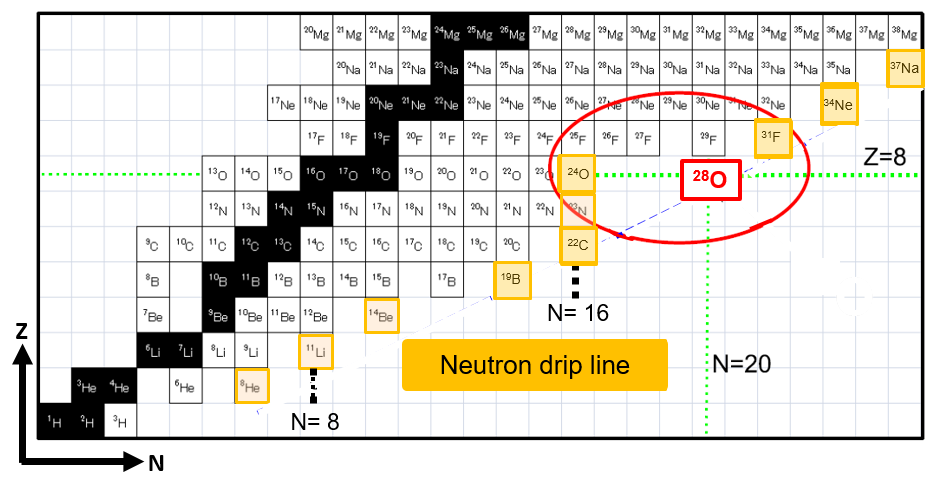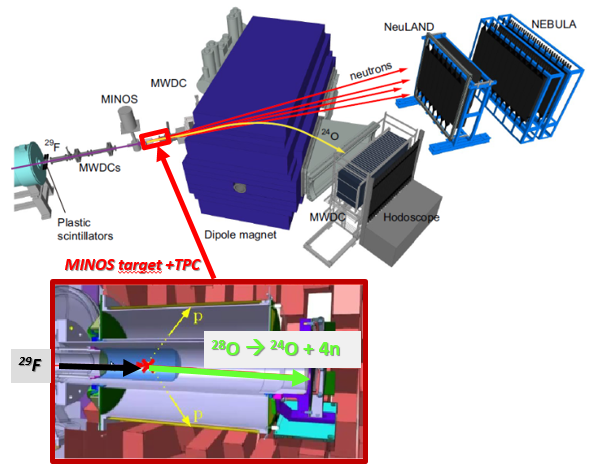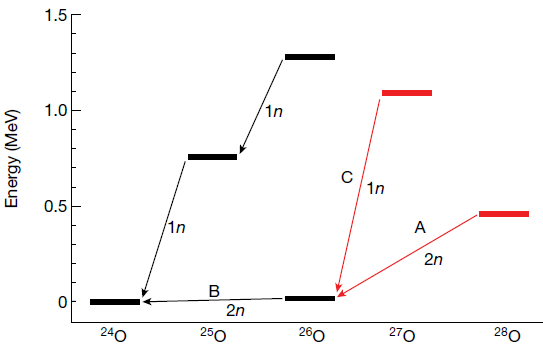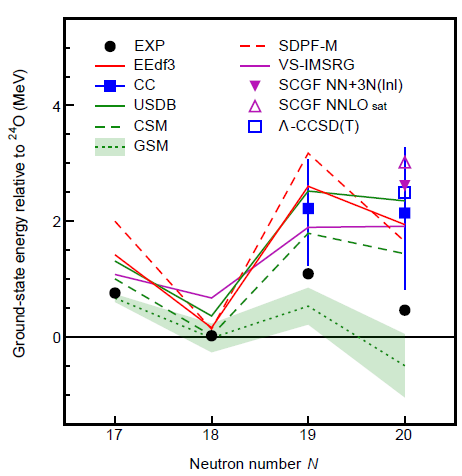For the first time, an experiment has provided key observations on the spectroscopy of the neutron-rich unbound oxygen nuclei (proton number Z = 8), oxygen 28 (N = 20) and its neighboring isotope at N = 19, oxygen 27. They were produced in high-energy reactions and observed by direct detection of their decay products, 24O and three or four neutrons. The study shows that it is possible to constrain the parameters of ab initio interactions from the energy differences of the observed states with respect to the last bound isotope - 24O (N = 16). These groundbreaking results were published in the journal Nature [Nat23].
Given the complexity of studying unbound nuclei, an exceptional detection system was implemented at the world's most powerful radioactive ion beam facility: RIBF in Japan. The data were obtained by an international collaboration (Samurai21) of around a hundred physicists (from 36 laboratories), including a team* of physicists from Irfu who were responsible for operating a key detector for the measurements, Minos. The experiment, carried out on the Samurai area of the RIBF (Radioactive Ion Beam Factory) facility at RIKEN in Japan, was piloted by groups of physicists from Titech (Tokyo Institute of Technology) and by the RIKEN-RIBF teams.
Background and motivations - Oxygen nuclei: from 16O to 28O, via oxygen 24, to the drip-line
If we consider an isotopic series, for a given number of protons (Z), the more neutrons an isotope contains, the shorter its lifetime and the less it is bound by the strong interaction.
A maximum limit in neutron number is reached, corresponding to the binding limit of an isotope in the series: this is the neutron drip-line (on the neutron-deficient side, the minimum limit in neutron number is the proton drip-line) (Figure 1). Beyond the drip-line, the neutron-rich isotope dissociates, decaying through neutron emission.
Thus, N = 16 marks the drip-line in oxygen isotopes, with oxygen 24 the last bound isotope [lifetime, 72 (5) ms], with N = 17-20 nuclei decaying by neutron emission. Depending on their neutron number, some nuclei beyond the drip-line, although unbound, can exist as narrow resonances, with lifetimes of the order of 10-21 s. These can be observed by producing them with nuclear reactions induced by exotic beams, and by detecting their decay products.
However, both the production (less than a few particles per second) and the implementation of coincident detection of reaction and decay products (fragments and all neutrons) represent complex challenges at the limits of the capabilities of current detection facilities and systems. To identify and study the new properties of these exotic, unbound nuclei, experimental programs have been set up by the international Samurai21 collaboration, including Irfu's Minos team.
Among the first key nuclei targeted by this program was oxygen 28, 28O. According to the standard shell model calculations, the 28O nucleus was considered as a doubly magic isotope, due to its numbers of protons (8) and neutrons (20). Most nuclear model calculations in the 2000s predicted that 28O would be the last bound nucleus in the isotopic chain. But because it is so exotic, with ten more neutrons than the last stable oxygen isotope, 18O, physicists wondered about its properties: does it have the character of a double magic nucleus, i.e. is it difficult to excite with neutron-closed shells? They also wanted to understand why oxygen 24 (N = 16) and not 28 is the last bound in the isotopic chain.

Fig. 1 Table of nuclei up to the magnesium isotopic chain (Z = 12), showing the location of the experimentally established neutron drip-line (extension known in 2023, up to neon 34 and sodium 37 nuclei). The black squares show stable nuclei, the others are radioactive (beta decay). The known double magic nuclei on this part of the table are, for the stable ones, helium 4 (Z = 2, N = 2) and oxygen 16 (Z = 8); for the unstable ones, oxygen 24 (N = 16).
Earlier RIKEN studies had shown that oxygen 24 has the properties of a doubly magic nucleus (a higher 2+ state than its neighboring isotopes, and therefore more difficult to excite). This corresponds to the appearance of a new magic number at N = 16. The phenomenon of neutron-closed shells at N = 16 would be associated with the disappearance of N = 20 in oxygen isotopes, also indicated by the instability of nuclei 27,28O, with a mechanism modifying the energy gaps of the filled shells at N = 16 (24O) and N = 20 (28O). This mechanism was mainly attributed to changes in spin-isospin interactions for very neutron-rich exotic nuclei. Its microscopic origin remains to be elucidated.
Uncertainties in theoretical calculations of nuclear properties depend on the assumptions made about many-body calculations and the interactions employed. As 28O represents a perfect case study of the persistence or otherwise of the doubly magical character far from the valley of stability, its properties (binding energy, excitations) constitute a strong constraint on models and their interactions. The main objective of the experiment was therefore to directly measure the energies of the unbound states of 28O (and 27O) and compare them with theoretical calculations.
A unique facility
With the beams produced on the RIBF facility, the Japanese accelerator at the RIKEN Nishina Center has been offering the highest intensities of exotic nuclei to the international nuclear physics community since 2007. The experiment was successfully carried out using a unique combination of the most powerful devices for measuring the particles produced in nuclear reactions (Figure 2):
- the RIBF beamline for the production of intense, neutron-rich beams (29F),
- the Minos active target system, a thick (151 mm) liquid hydrogen (proton) reaction target,
- and a set of highly efficient neutron multi-detectors (detection of neutron decay products) coupled to the Samurai spectrometer (24O detection).

Figure 2. The complete setup on the Samurai site, zooming in on the MINOS target. The thick liquid hydrogen target is in blue, and the trace detector is in mauve-gray. Neutrons were detected by the NEBULA and NeuLAND neutron multidetectors in coincidence with the fragment (oxygen 24) measured by the Samurai spectrometer. From the identified reaction products (oxygen 24 and a sequence of neutrons) and their measured energies, it is possible to deduce the energy of the nucleus at the origin of the decay (so-called invariant mass analysis) and to determine the precise mechanism at work to explain the decay steps of oxygen 27 or oxygen 28.
Minos [Minos] has been entirely developed at CEA-Irfu for this type of experiment. This reaction and detection system consists of a thick liquid hydrogen target (in blue on Fig. 2) and a time-projection chamber (TPC) surrounding the target (in gray-purple, Fig. 2). The TPC, built using the Micromegas technique, is used to measure particle tracks in the target and reconstruct the reaction vertex. Irfu's Minos group was responsible for operating the device, which was crucial to the success of the experiment. The 29F RIBF beam is the most intense in the world, but as the intensity is low (on average, 90 nuclei per second), Minos was essential for increasing the luminosity of the experiment: the high number of target nuclei (hydrogen) enabled the reactions of interest producing the 27,28O nuclei to be measured with sufficient statistical accuracy, while maintaining good resolution of the energies of the nuclei measured, through detection of the reaction vertex.
The experiment
The Minos target was bombarded with a beam of 29F nuclei produced at 235 MeV/n, which induced nuclear reactions on the target protons, producing oxygen 28 and two protons. As the 27,28O nuclei are unbound, they are only observed as resonances. As soon as they are produced, they dissociate into a fragment and neutrons, either directly or in steps. Thus 28O is likely to produce: 24O + 4n by passing through the unbound state of 27O : 28O→ 27O+n → (24O + 3n) + n or the unbound state of 26O, following the sequence : 28O → 26O + 2n → 24O + 2n.
Measurements and results.
Les énergies de décroissance des résonances des 27,28O ont été déduites des ajustements sur les pics des histogrammes des énergies de décroissance partielle de trois (E0123) ou quatre neutrons en coïncidence (E01234) (Figure 3). Pour l'28O, une énergie de décroissance E01234 a été mesurée à 0.46 MeV avec une erreur statistique (stat) : − 0.04 ; + 0.05 MeV et une erreur systématique : 0.02 (syst) MeV. La limite supérieure de la largeur de la résonance est de 0.7 MeV (avec un intervalle de confiance de 68 %). Cette mesure permet de conclure que l’état fondamental a bien été observé.
Dans le cas de l'27O, une énergie de décroissance E0123 a été mesurée à 1.09 ± 0.04 (stat) ± 0.02 (syst) MeV.
Ces mesures fournissent un premier résultat majeur : les valeurs expérimentales sont incompatibles avec les valeurs attendues (quelles que soient les théories) pour un noyau à couches fermées en neutrons à N = 20.

Figure 3 (extracted from the Nature article).
Decay level diagram of unbound oxygen isotopes (A=25-28) towards the last bound isotope, Oxygen-24. Newly observed resonances and their decays are shown in red.
Figure 3 shows the measured energies of 27O and 28O produced by removing a proton from 29F. The experimental values obtained at 1.09 MeV and 0.46 MeV are associated with the observed decays.
Interpretation. Nuclear interaction parameters.
The new data can be used as a testing ground for model parameters. Figure 4 shows the experiment-theory comparison for the energy difference between the binding energy of oxygen isotopes for N = 17 to 20, and that of 24O (the last bound isotope). The calculations were carried out within the framework of several models performing well in this isotope region. Within this variety of models, the question is which techniques and interactions are best able to account for the observed evolution.
Without going into too much detail, the models differ either in their techniques for calculating the many-body problem, or in the parameters of the nuclear interactions employed. For example, the values given by the ab initio SCGF approach [SCGF] differ according to two types of interaction: NNLOsat (empty triangle) and NN+3N (lnl) (solid triangle).
Consequences on the nuclear theories
Apart the GSM approach (Gamow Shell Model, a model incorporating the continuum effects), all calculations overestimate the experimental values for the 27,28O isotopes.
The unbound oxygen nuclei 27 and 28 thus enable us to test the models and their interactions in a region of extremely neutron-rich nuclei (N/Z = 2.5 for 28O, compared with the last bound 24O, N/Z = 2, and the last stable isotope 18O: N/Z = 1.25).
The discrepancies suggest that the chiral interactions should be revisited: it will be investigated whether finer tuning of the chiral interaction parameters would yield 27O and 28O energies (relative to 24O) within the measured ranges. As the confidence intervals are wide, this shows that the energies of these isotopes are essential anchor points for microscopic approaches to nuclear interactions.

Figure 4 (extracted from the Nature article).
Ground-state energy for isotopes A=25-28 relative to that of the nucleus of oxygen 24, the last bound isotope. The results in the article are the points for A = 27, 28. The points at A = 25, 26 are taken from literature atomic mass tables.
Experimental values are represented by the black dots (uncertainties are smaller than the size of the dots). They are compared with the calculations described in the text.
The shaded band of GSM calculations shows uncertainties related to continuum couplings in pf shells. The vertical lines of the CC calculations show the 68% confidence interval.
With the resonances highlighted in the Nature article, it has now been proven that the unbound 28O nucleus does not possess the characteristics of double magic shells. In addition, the article presents a study of the constraints placed on ab initio theories by the measured ground-state energies of oxygen nuclei 27 and 28. These energies can be used as key parameters for future ab initio interactions, with the aim of improving their predictive power on the properties of all nuclei.
Références
[Nat23] First observation of 28O, Y. Kondo et al., the Samurai21 collaboration, published in Nature 2023. Nature 620, pp. 965-970 (2023). [ doi : https://doi.org/10.1038/s41586-023-06352-6 ] [ Open access: https://www.nature.com/articles/s41586-023-06352-6 ]
[Minos] MINOS, acronym for Magic Number Off Stability. Page of the Minos project developed at IRFU: https://irfu.cea.fr/dphn/Phocea/Vie_des_labos/Ast/ast_technique.php?id_ast=3016
[SCGF] The SCGF (self-consistent Green’s function) approach is developed at CEA DPhN by the nuclear structure theory group https://irfu.cea.fr/Phocea/Vie_des_labos/Ast/ast_visu.php?id_ast=4070
The SCGF calculations of the Nature article are described in: V. Somà, P. Navrátil, F. Raimondi, C. Barbieri, T. Duguet, Novel chiral Hamiltonian and observables in light and medium-mass nuclei. Phys. Rev. C 101, 014318 (2020).
*The MINOS-IRFU team for the Samurai21 campaign: A. Corsi, A. Obertelli, G. Authelet, D. Calvet, F. Château, A. Delbart, J.-M. Gheller, A. Giganon, A. Gillibert, V. Lapoux, C. Péron, A. Peyaud, E.C. Pollacco, J.-Y. Roussé.
Contacts DPhN : Anna Corsi, Valérie Lapoux
• Structure of nuclear matter › Atomic nucleus Structure de la matière nucléaire
• Le Département de Physique Nucléaire (DPhN) • The Nuclear Physics Division
• Laboratoire d'Etudes du Noyau Atomique (LENA) • LENA group - Structure of the Atomic Nuclei
• MINOS



